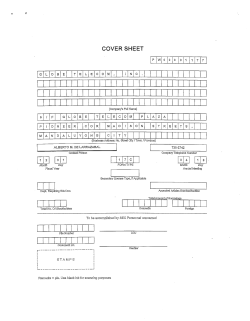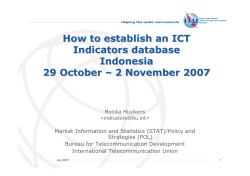
Global trends in telecom development Tim Kelly (ITU) CTO Annual Council, Gaborone,
Global trends in telecom development Tim Kelly (ITU) CTO Annual Council, Gaborone, 20 September 1999 The views expressed in this presentation are those of the author, and do not necessarily reflect the opinions of the ITU or its membership. Tim Kelly can be contacted by e-mail at: Tim.Kelly@itu.int. Global trends in telecom development The state of the industry Fixed-lines Mobile The Internet The state of the market Increasing competition Private sector participation Independent regulation The shape of things to come The changing telecom development gap The industry in 2005 Key policy issues Projection of growth trends, fixed and Subscribers (million) 1'500 1'250 300 Fixed main lines 250 Mobile subscribers 1'000 Total int'l traffic 200 750 150 500 100 250 50 0 0 1995 1996 1997 1998 1999 2000 2001 2002 2003 2004 2005 Source: ITU. Billions of minutes of int’l traffic cellular subscribers and int’l traffic, 1995-2005 The changing pie: Global telecom service revenue, 1998 Other (incl. Internet, leased lines, telex), 10.6% Domestic fixedline revenues, 59.2% Mobile service revenues, 21.2% International revenues, 8.8% 1998 Telecom service revenue. Total = US$724b Source: ITU “World Telecommunication Development Report 1999: Mobile cellular” (forthcoming) Projection of revenue growth (US$bn) 1000 Service revenue (US$ bn) 900 800 700 Actual Projected Other: Data, Internet, Leased lines, telex, etc 600 500 Mobile Int'l 400 300 200 100 Domestic Telephone/fax 0 90 91 92 93 94 95 96 97 98 99 00 01 02 Source: ITU. Internet hosts (million) July 1993-July 1999 56.2 Compound Annual Growth Rate = 61.8% 36.7 26.1 16.7 8.2 1.8 Jul-93 3.2 Jul-94 Jul-95 Jul-96 Jul-97 Jul-98 Source: ITU “Challenges to the Network: Internet for Development, 1999”, Network Wizards. Jul-99 Distribution of Internet hosts, January 1998 Australia, Japan & New Zealand 7.0% Canada & US 64.1% Other 4.6% Europe, 24.3% Developing Asia-Pacific 2.9% LAC* 1.2% Africa 0.5% Source: ITU “Challenges to the Network: Internet for development, 1999”. The state of the market Increasing competition Around two-thirds of telecom subscribers now have a choice of operator More than 99 per cent of mobile and Internet subscribers now have a choice of operator Dominantly private-ownership 19 out of top 20 top public telecom operators are partially or fully private-owned Of the top 20 mobile operators, 16 are fullyprivate, 3 are partially private, 1 is state-owned Independent regulators There are currently 84 independent regulators (only 12 in 1990) Degree of competition by service, 1999 (ITU Member States) Monopoly 80% Duopoly Competition 70% 60% 50% 40% 30% 20% 10% 0% Basic services Cellular Source: ITU Telecommunication Regulatory Database. Cable TV ISPs Degree of competition in basic services, 1999, by region 90% Monopoly Duopoly Competition 80% 70% 60% 50% 40% 30% 20% 10% 0% Africa Americas Source: ITU Telecommunication Regulatory Database. AsiaPacific Arab States Europe Increasing competition: By no. of countries, by service, 1995-2005 Countries 100 Local Long distance International 90 80 70 60 50 40 30 20 10 0 1995 1997 1999 Source: ITU Telecommunication Regulatory Database. 2001 2003 2005 Percentage of outgoing international traffic open to competition Monopoly 74% 35% 85% Competition 46% 4 14 29 48 1990 1995 1998 2005 Number of countries permitting more than one operator for international telephony Note: Analysis is based on WTO Basic Telecommunications Commitments and thus presents a minimum level of traffic likely to be open to competitive service provision. Source: ITU, WTO. Recent privatisation transactions 1995 Source: ITU Telecommunication Regulatory Database. Note: Some countries made sales in several tranches (e.g., Spain) 1996 Bolivia Belgium Cape Verde Germany Cuba Ghana Czech Rep. Greece Indonesia Guinea Mongolia Hungary Portugal Indonesia Spain Ireland Korea Peru Portugal Singapore Venezuela 1997 Armenia Australia Cote d'Ivoire France Greece Hungary India (MTNL) India (VSNL) Israel Italy Kazakhstan Panama Portugal Senegal Serbia South Africa Sri Lanka Spain 1998 Brazil Denmark (2) France El Salvador Finland Guatemala Lithuania Malta Poland Puerto Rico Romania Switzerland Telecom Privatisations in Africa Country Year % Cape Verde 1995 Price Partner US$m 40% 40 Portugal Telecom Côte d’Ivoire 1997 51% 210 France Telecom Ghana 1996 30% 38 Telekom Malaysia Guinea 1996 60% 45 Telekom Malaysia GuineaBissau Sao Tomé & Principe Senegal 1989 51% 3 Portugal Telecom 1989 51% 1 Portugal Telecom 1997 33% 90 FT-led consortium South Africa 1997 30% Source: ITU Telecommunication Regulatory Database. 1’260 SBC/Telekom Malaysia Ownership status of the incumbent Private Countries State-owned 160 140 120 100 80 60 40 20 0 1991 1993 Source: ITU Telecommunication Regulatory Database. 1995 1999 Separate regulatory bodies, worldwide, 1998 Source: ITU Telecom Regulatory Database. Separate The development gap is shrinking but also shifting The share of the telecom market of Low & Lower-middle income countries: Fixed-lines: 1984 = 13%; 1998 = 27% Mobile: 1990 = 1.4%; 1998 = 12% Internet hosts: 1993 = 0.1%; July 1999 = 1.7% Some LDCs and CIS Republics are falling further behind in fixed-line networks No growth or decline between 1995-98 in Afghanistan, Armenia, Burundi, DPR Congo, Haiti, Kazakhstan, DPR Korea, Kyrgyzstan, Sierra Leone, Somalia, Tajikistan, Uzbekistan, Zambia “The future is here, it’s just not evenly distributed” William Gibson Teledensity 1996 27.8 8.6 1.4 0 to to to to 68.3 27.8 8.6 1.4 (46) (45) (47) (48) Source: ITU World Telecommunication Indicators Database. Forecasting to 2005 Projecting forward current trends By 2005, there could be: 1.4 billion telephone lines 1.1 billion cellular telephone subscribers 400-500 million Internet users These could account for: 250 billion minutes of int’l voice/fax traffic 2.5 trillion minutes of total voice/fax traffic 1’000’000 Gigabits (1 Petabit) per second of Internet traffic Services market of around US$1.1 trillion Equipment market of around US$400 billion Forecasting to 2005 Identifying discontinuities By 2001, less than 10% of int’l traffic will use accounting rate system Domestic interconnect fees will be dominant mode Major price cuts in international calls after 2002/2003 Availability of new infrastructures Impact of Internet pricing model (distance and duration independent) Mobiles exceed fixed-line phones in most OECD countries by 2004/2005 Introduction of “third generation” mobiles after 2001 Generational shift, as new users reject fixed-lines The int’l telecoms market in 2005: Some educated guesses The premium of an international call over a domestic call (currently >300%) will be <20% Internet-like pricing structure Traffic flows will be dictated by a small number of hubs connected to multiple fat pipes Major hubs in New York, London and Hong Kong? Major alliances will own a smaller share of the market as infrastructure owners resell capacity Market significantly bigger by volume, but only slightly bigger by revenue Telecom development gap will shift Gap between middle income countries and LDCs Key policy issues to be tackled Interconnection How to manage the transition to a multi-player environment? Internet Who really sets the rules? Who really gets benefits? International settlements How to transition to a cost-oriented system while providing a “soft-landing” for developing countries? International infrastructures How to ensure equal access at competitive rates? Investment How to increase investment, esp in LDCs?
© Copyright 2025





















